Cochiti Pueblo Pottery Storyteller Figurines Exhibit
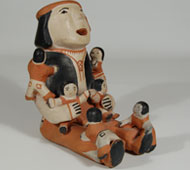 The storyteller figurine tradition started with one potter at Cochiti Pueblo in 1964. That potter, Helen Cordero, made the first image as a tribute to her grandfather who was known to be an accomplished storyteller of the pueblo. Little did she know that she was starting a new convention and innovation in pueblo pottery production. From that first storyteller figurine, many more have appeared. From that first potter to make one, many others have followed.
The storyteller figurine tradition started with one potter at Cochiti Pueblo in 1964. That potter, Helen Cordero, made the first image as a tribute to her grandfather who was known to be an accomplished storyteller of the pueblo. Little did she know that she was starting a new convention and innovation in pueblo pottery production. From that first storyteller figurine, many more have appeared. From that first potter to make one, many others have followed.
Since the very first storyteller figurine was created at Cochiti Pueblo, this exhibit is dedicated to showing figurines only from Cochiti Pueblo. There are over 100 storyteller and other pottery figurines made by more than 25 potters being exhibited and all are available for sale.
San Ildefonso Eagle Feather Design Plate signed Marie & Santana - C3661F
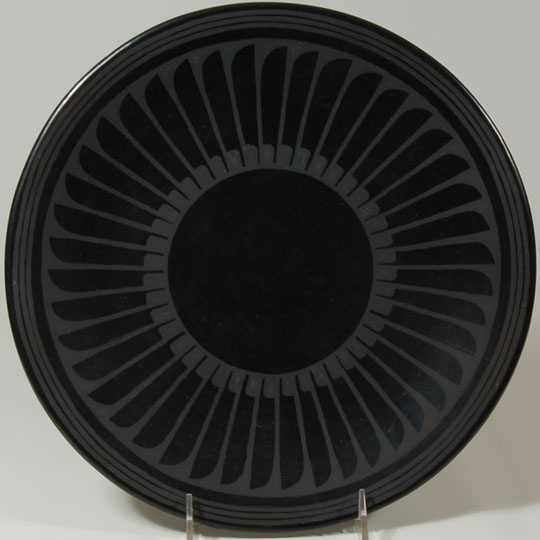 Maria and Julian Martinez had four sons: Adam, John, Popovi Da, and Philip. Adam's wife was Santana and it was she who worked with Maria following the death of Julian in 1943. There are two periods of pottery that were collaborated by Maria and Santana. The earlier ones were signed Marie + Santana and that period lasted from Julian's death in 1943 until 1956, at which time Popovi Da replaced Santana and helped his mom. Maria did not immediately stop working with Santana when she began working with Popovi but did continue on and off for a few more years. Those later pieces are signed Maria + Santana.
Maria and Julian Martinez had four sons: Adam, John, Popovi Da, and Philip. Adam's wife was Santana and it was she who worked with Maria following the death of Julian in 1943. There are two periods of pottery that were collaborated by Maria and Santana. The earlier ones were signed Marie + Santana and that period lasted from Julian's death in 1943 until 1956, at which time Popovi Da replaced Santana and helped his mom. Maria did not immediately stop working with Santana when she began working with Popovi but did continue on and off for a few more years. Those later pieces are signed Maria + Santana.
Cloud Design Black-on-black Jar signed Marie & Julian - C3661B
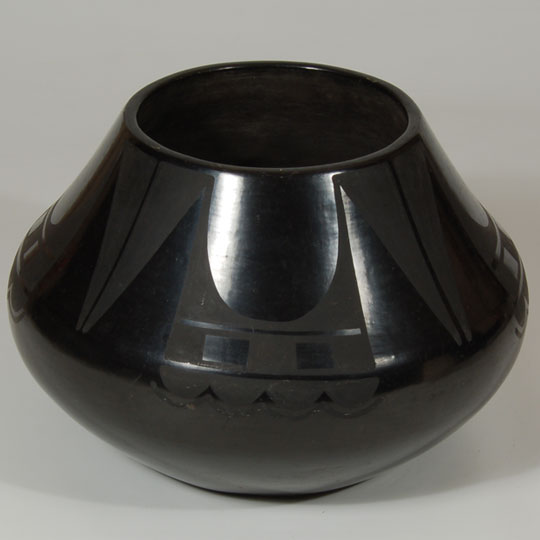 Maria Poveka Martinez (1887-1980) and Julian Martinez (1885-1943) worked together producing pottery from the early 1900s-she making the beautiful Tewa shape vessels and he painting beautiful designs in traditional Polychrome style. Because Maria was considered the best potter at San Ildefosno Pueblo, she was selected to experiment on reproducing the prehistoric wares being excavated. She and Julian worked diligently for several years to recreate the earlier pottery and Julian painted designs in the traditional Polychrome style. It was not until around 1912, that they became interested in experimenting with the blackware of previous periods. It was another 10 years before they achieved satisfactory results.
Maria Poveka Martinez (1887-1980) and Julian Martinez (1885-1943) worked together producing pottery from the early 1900s-she making the beautiful Tewa shape vessels and he painting beautiful designs in traditional Polychrome style. Because Maria was considered the best potter at San Ildefosno Pueblo, she was selected to experiment on reproducing the prehistoric wares being excavated. She and Julian worked diligently for several years to recreate the earlier pottery and Julian painted designs in the traditional Polychrome style. It was not until around 1912, that they became interested in experimenting with the blackware of previous periods. It was another 10 years before they achieved satisfactory results.
Original Navajo Painting of a Masked Yei Dancer by Adee Dodge - C3241G
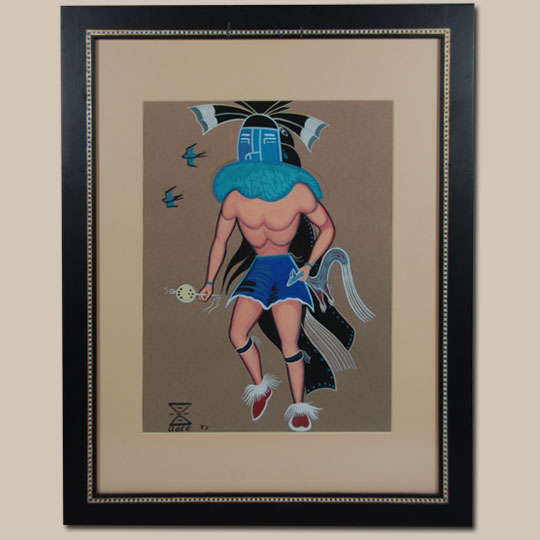 Adee Dodge was the grandson of the first Navajo Tribal Chairman, Chee Dodge. He studied at the University of New Mexico and received a master's degree from Columbia University in Comparative Linguistics and Anthropology. He started painting while recovering from war wounds he received while serving in the South Pacific during World War II. A self-taught painter, he focused his work on preserving the symbols and stories of the Navajo Religion. His work has been featured in Arizona Highways and at the Smithsonian.
Adee Dodge was the grandson of the first Navajo Tribal Chairman, Chee Dodge. He studied at the University of New Mexico and received a master's degree from Columbia University in Comparative Linguistics and Anthropology. He started painting while recovering from war wounds he received while serving in the South Pacific during World War II. A self-taught painter, he focused his work on preserving the symbols and stories of the Navajo Religion. His work has been featured in Arizona Highways and at the Smithsonian.
Glossary of Southwest Native American Art Terms
From time to time Adobe Gallery uses terms to describe Southwest Indian pottery, paintings, rugs, jewelry, and more that you may not be familiar with. No worries we got you covered. Check out the link below. If you don't see the term in the glossary, please give us a call and we will be glad to help you.
Zuni Pueblo Sun Face Dangle Petit-point Earrings - C3666E
 Zuni Pueblo craftsmen are known for two types of stonework, inlay and petit-point. These wonderful Southwest Indian Jewelry earrings from an unknown jeweler have incorporated both types. The small sun face is inlaid with shell, turquoise and jet. Below the inlaid sun face is a petit-point base with five petit-point dangles falling from the bottom of the base. The earrings have a post back.
Zuni Pueblo craftsmen are known for two types of stonework, inlay and petit-point. These wonderful Southwest Indian Jewelry earrings from an unknown jeweler have incorporated both types. The small sun face is inlaid with shell, turquoise and jet. Below the inlaid sun face is a petit-point base with five petit-point dangles falling from the bottom of the base. The earrings have a post back.
Zuni Pueblo Channel Inlay Bird Earrings - C3666G
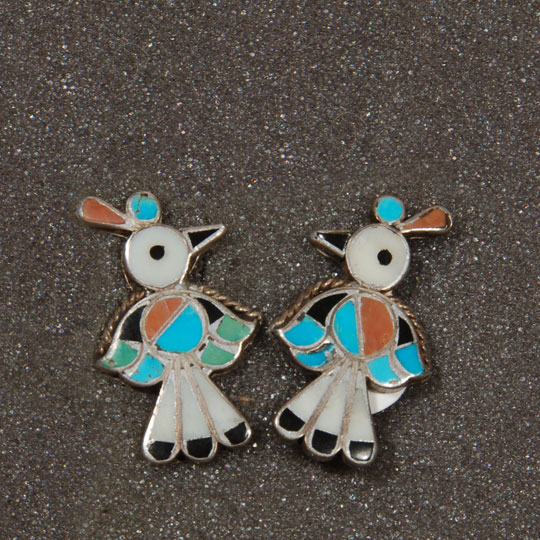 Zuni Pueblo artists are known for their remarkable ability to set the smallest pieces of stone into precisely laid out silver channels. These bird earrings are an example of the finest Zuni craftsmanship of the second half of the twentieth century. The unknown artist has used turquoise and jet for wings. The shell and jet tail feathers are set in silver channels. The head of the Southwest Indian Jewelry bird is white shell with perfectly set black jet eye and beak. These earrings are screw back.
Zuni Pueblo artists are known for their remarkable ability to set the smallest pieces of stone into precisely laid out silver channels. These bird earrings are an example of the finest Zuni craftsmanship of the second half of the twentieth century. The unknown artist has used turquoise and jet for wings. The shell and jet tail feathers are set in silver channels. The head of the Southwest Indian Jewelry bird is white shell with perfectly set black jet eye and beak. These earrings are screw back.
Zuni Pueblo Inlay Sun Face Earrings - C3666F
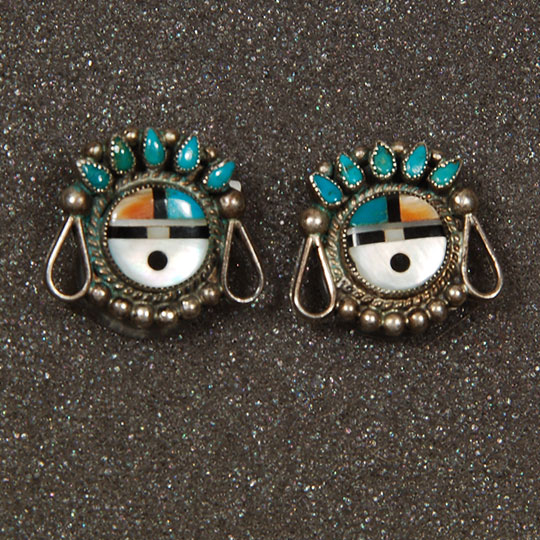 Zuni Pueblo artisans are known for fine stone work placed in delicate sterling settings. This pair of earrings is an excellent example of traditional Southwest Indian Jewelry from Zuni Pueblo. The unknown artist has set turquoise, white shell and jet to form a pair of perfect little sun faces set in a sterling silver setting. This pair is unique in that the artist has added slender silver earrings on the side of each face.
Zuni Pueblo artisans are known for fine stone work placed in delicate sterling settings. This pair of earrings is an excellent example of traditional Southwest Indian Jewelry from Zuni Pueblo. The unknown artist has set turquoise, white shell and jet to form a pair of perfect little sun faces set in a sterling silver setting. This pair is unique in that the artist has added slender silver earrings on the side of each face.
UITA 21 Silver and Turquoise Navajo Flower Pin - C3666D
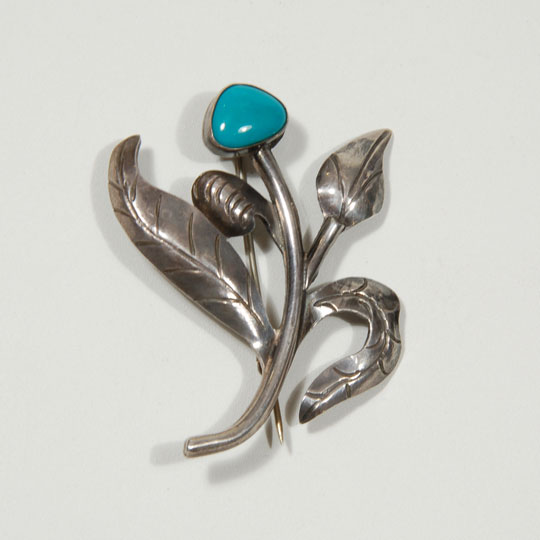 United Indian Traders Association (UITA) was formed in 1931 to insure quality craftsmanship in Native American art. The association had strict rules regarding the methods used to make jewelry. A UITA stamp was a guarantee the piece was hand made by a member of an enrolled tribe. Traders paid dues and each post had its own number. UITA 21 was the number for the Santa Fe store owned by trader Julius Gans. Thus, we are able to identify that this Southwest Indian Jewelry piece was made and sold originally in Santa Fe.
United Indian Traders Association (UITA) was formed in 1931 to insure quality craftsmanship in Native American art. The association had strict rules regarding the methods used to make jewelry. A UITA stamp was a guarantee the piece was hand made by a member of an enrolled tribe. Traders paid dues and each post had its own number. UITA 21 was the number for the Santa Fe store owned by trader Julius Gans. Thus, we are able to identify that this Southwest Indian Jewelry piece was made and sold originally in Santa Fe.
Large Navajo Sterling Silver and Turquoise Butterfly Pin - C3666C
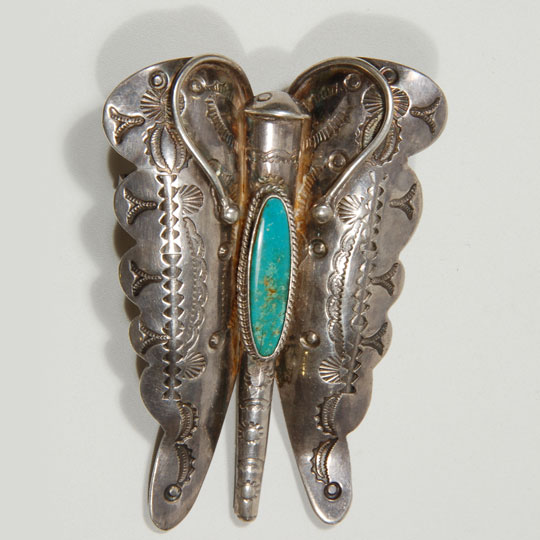 The exquisite stamp work on this butterfly pin mimics the wings of a real butterfly. The unknown Navajo artist has used a variety of stamps to form life-like wings. An oval piece of natural turquoise sits between the wings and is set upon a sterling cylinder. At the top of the cylinder, the artist has stamped a friendly face, adding a human dimension to the Southwest Indian Jewelry pin. As a final touch, long strands of silver compose a pair of long antennae. It is a beautifully crafted piece, a great addition to anyone who wants to add a fine piece of mid-century Navajo stamped jewelry to their collection.
The exquisite stamp work on this butterfly pin mimics the wings of a real butterfly. The unknown Navajo artist has used a variety of stamps to form life-like wings. An oval piece of natural turquoise sits between the wings and is set upon a sterling cylinder. At the top of the cylinder, the artist has stamped a friendly face, adding a human dimension to the Southwest Indian Jewelry pin. As a final touch, long strands of silver compose a pair of long antennae. It is a beautifully crafted piece, a great addition to anyone who wants to add a fine piece of mid-century Navajo stamped jewelry to their collection.
Kewa Pueblo Glass Bead and Coin Necklace - C3666A
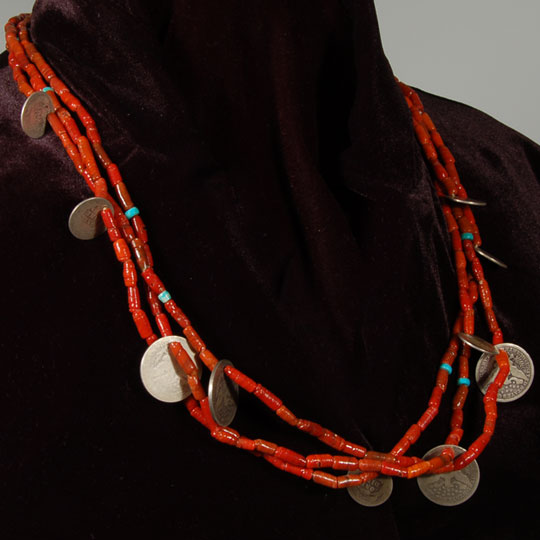 This three-strand necklace is made of deep red glass beads, small turquoise beads and old silver dimes and quarters. The oldest coin is dated 1892 and the most recent is a 1910 silver dime. All of the coins are Barber coins. Barber dimes, quarters and halves were only minted between 1892 and 1916. They were named after the Mint engraver who designed them, Charles E. Barber. The glass beads are most likely European made. Pueblo women used European beads frequently in the early twentieth century.
This three-strand necklace is made of deep red glass beads, small turquoise beads and old silver dimes and quarters. The oldest coin is dated 1892 and the most recent is a 1910 silver dime. All of the coins are Barber coins. Barber dimes, quarters and halves were only minted between 1892 and 1916. They were named after the Mint engraver who designed them, Charles E. Barber. The glass beads are most likely European made. Pueblo women used European beads frequently in the early twentieth century.
Historic Cochiti Pueblo Storage Jar with Lid - C3668B
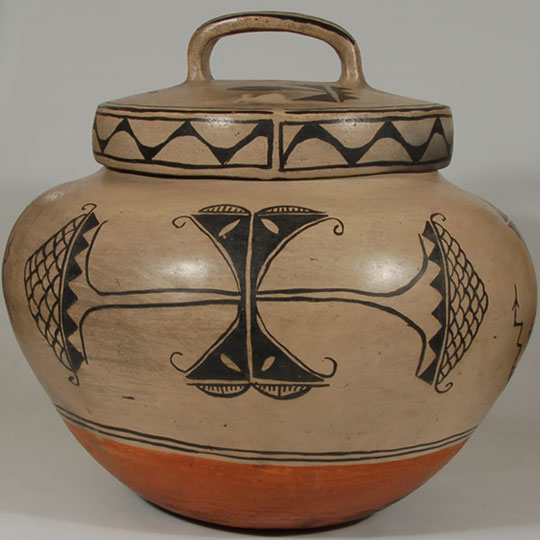 The history of pottery vessels from Cochiti Pueblo is more of an early 20th century phenomenon than earlier. Collections made for the Smithsonian in 1880 were almost void of ollas and bowls but consisted of figurines and effigy vessels. Why did Cochiti potters not make ollas, storage jars, and bowls? Apparently they preferred to get them from Acoma, Zia and Zuni Pueblos-pueblos with stronger vessels and with more interesting designs than that which was traditional at Cochiti? Perhaps Cochiti potters appreciated the beauty of pottery from the other pueblos or perhaps making figurative pottery was so ingrained in the culture, that it had become a way of life for Cochiti potters.
The history of pottery vessels from Cochiti Pueblo is more of an early 20th century phenomenon than earlier. Collections made for the Smithsonian in 1880 were almost void of ollas and bowls but consisted of figurines and effigy vessels. Why did Cochiti potters not make ollas, storage jars, and bowls? Apparently they preferred to get them from Acoma, Zia and Zuni Pueblos-pueblos with stronger vessels and with more interesting designs than that which was traditional at Cochiti? Perhaps Cochiti potters appreciated the beauty of pottery from the other pueblos or perhaps making figurative pottery was so ingrained in the culture, that it had become a way of life for Cochiti potters.
Pair of Paintings of Zia Pueblo Deer Dancers by Rafael Medina - C3786A-B
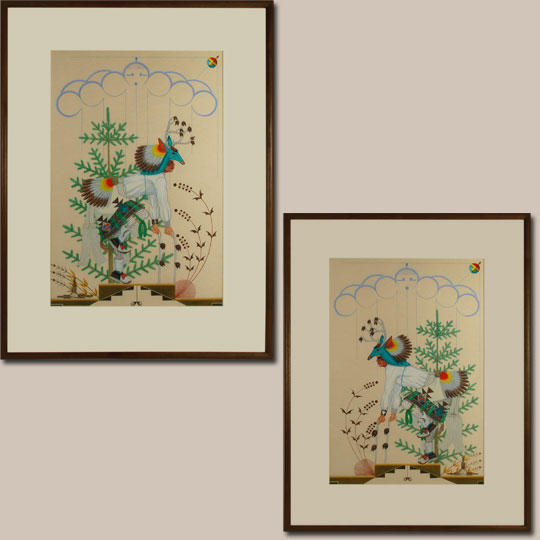 Rafael Medina (Teeyacheena) was born at Zia Pueblo and was educated at Zia Day School, Albuquerque Indian School and Santa Fe Indian School. Much of his work bears the influence of Santa Fe Indian School founder Dorothy Dunn, who taught her students the traditional "flat style" for which many of them became well known. These two paintings are clearly rooted in that style but also expand upon it, adding dimension, depth and color to the familiar profile of a Zia Deer Dancer.
Rafael Medina (Teeyacheena) was born at Zia Pueblo and was educated at Zia Day School, Albuquerque Indian School and Santa Fe Indian School. Much of his work bears the influence of Santa Fe Indian School founder Dorothy Dunn, who taught her students the traditional "flat style" for which many of them became well known. These two paintings are clearly rooted in that style but also expand upon it, adding dimension, depth and color to the familiar profile of a Zia Deer Dancer.
Plains Indian Warrior with Feathered Headdress by Wo-Peen - C3669B
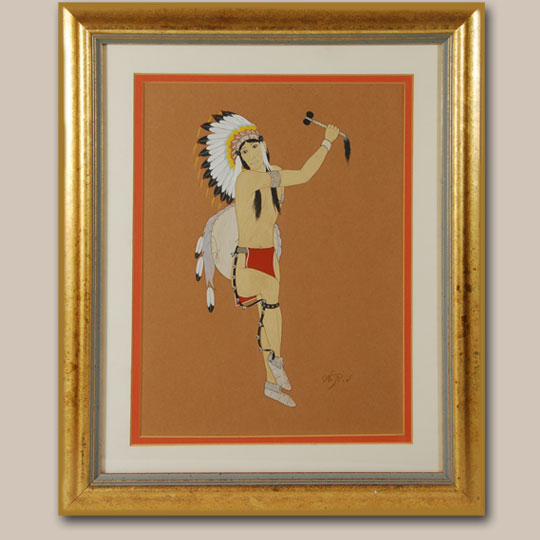 Luis Gonzales painted actively in the late 1920s but an accident that caused the loss of his right hand caused him to cease painting in the 1960s. His short career resulted in production of fewer paintings of any of the group of artists from San Ildefonso. There were few painted during his career and fewer on the market today.
Luis Gonzales painted actively in the late 1920s but an accident that caused the loss of his right hand caused him to cease painting in the 1960s. His short career resulted in production of fewer paintings of any of the group of artists from San Ildefonso. There were few painted during his career and fewer on the market today.
The northern pueblos were influenced by Plains Indian culture and often painted images of Plains Indians wearing feathered head bonnets. This painting is a good example of such an event. The warrior appears to be dancing, his right leg up, and his arm in motion. It is quite likely that he is a San Ildefonso dancer and he is performing a dance relating to the Plains culture. San Ildefonso and other northern New Mexico pueblos perform a Comanche Dance on a regular basis.
Zuni Pueblo Child Size Olla with White Underbody, circa 1880s - C3654D
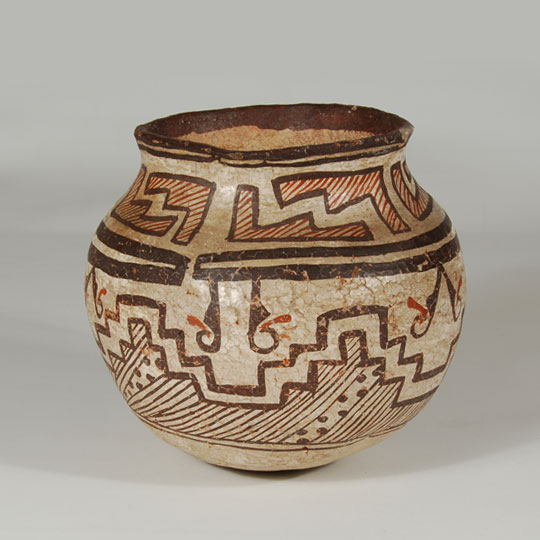 It appears that small jars, such as this one, that are totally slipped in white clay date to the late 1800s. No specific dates are provided in Harlow and Lanmon's book entitled The Pottery of Zuni Pueblo but examples of small pottery vessels with white slip are dated in the 1880-1890 decade, when illustrated in the book. We are therefore dating this jar circa 1880s.
It appears that small jars, such as this one, that are totally slipped in white clay date to the late 1800s. No specific dates are provided in Harlow and Lanmon's book entitled The Pottery of Zuni Pueblo but examples of small pottery vessels with white slip are dated in the 1880-1890 decade, when illustrated in the book. We are therefore dating this jar circa 1880s.
The bottom of the vessel is slightly rounded with no concave depression. The rim rolls out from the neck and is painted brown. The entire vessel was slipped in white clay and decorated with mineral brown and red colors. Red is at a minimum on the body of the jar but appears in abundance in the neck design.
Acoma Pueblo Jar Converted to a Table Lamp - C3753.59
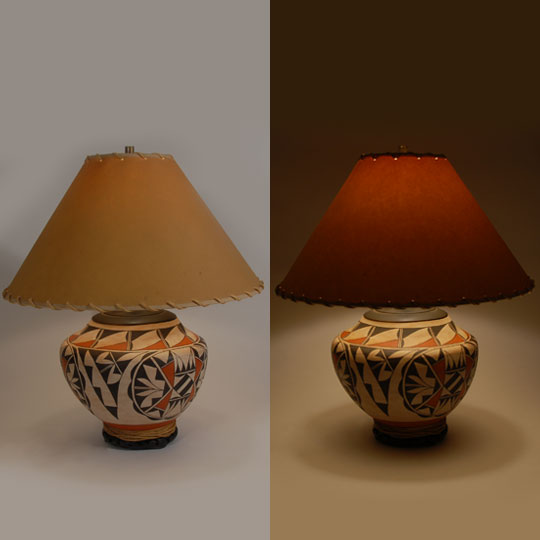 Traditional Pueblo pottery jars have been converted into table lamps since the 1930s. They were very popular in Santa Fe homes, some homes having several lamps from various pueblos. This lamp was made from a traditional Acoma olla that probably dates to the 1940s. The base of the olla is covered by the attached wooden base so there is no way to conveniently determine if the olla is signed or not.
Traditional Pueblo pottery jars have been converted into table lamps since the 1930s. They were very popular in Santa Fe homes, some homes having several lamps from various pueblos. This lamp was made from a traditional Acoma olla that probably dates to the 1940s. The base of the olla is covered by the attached wooden base so there is no way to conveniently determine if the olla is signed or not.
Contemporary Zia Pueblo Polychrome Serving Bowl - C3753.24
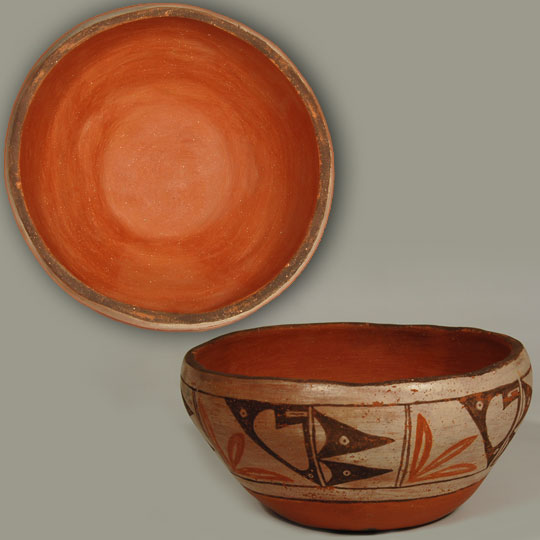 This is a traditionally-made serving bowl from Zia Pueblo, created most likely in the mid-20th century. This excellent medium-size bowl was coil-formed of native clay with the addition of crushed basaltic temper. The underbody's bare paste was stone-polished to a warm brick-red color. The design field was covered in traditional cream slip over which the design of geometric elements was painted. The rim of the bowl curves inward just so slightly and displays a very slight concave slope.
This is a traditionally-made serving bowl from Zia Pueblo, created most likely in the mid-20th century. This excellent medium-size bowl was coil-formed of native clay with the addition of crushed basaltic temper. The underbody's bare paste was stone-polished to a warm brick-red color. The design field was covered in traditional cream slip over which the design of geometric elements was painted. The rim of the bowl curves inward just so slightly and displays a very slight concave slope.
Historic Kewa (Santo Domingo) Pueblo Small Dough Bowl - C3753.39
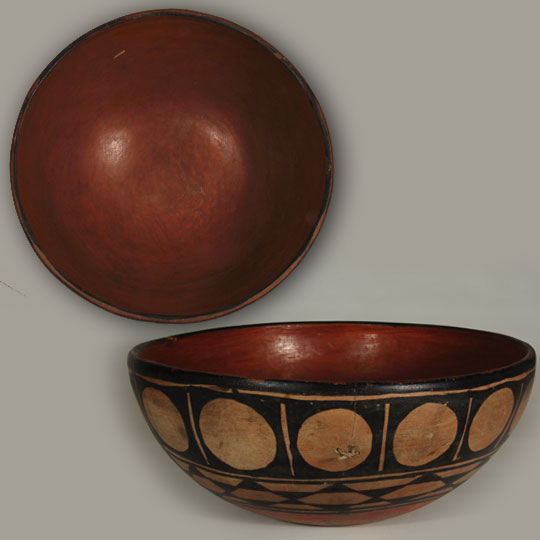 One of the strongest decorative elements in historic Kewa pottery is a black rectangular element that forms an unpainted circle. The circle appears to be the design but it is achieved by painting around it with black vegetal paint. Another favorite design placed on bowls consists of black triangles arranged in the shape of a star. This bowl is the first I've seen that features both of those elements.
One of the strongest decorative elements in historic Kewa pottery is a black rectangular element that forms an unpainted circle. The circle appears to be the design but it is achieved by painting around it with black vegetal paint. Another favorite design placed on bowls consists of black triangles arranged in the shape of a star. This bowl is the first I've seen that features both of those elements.
This is an excellent example of the finest work from Santo Domingo in the early 20thcentury. The black guaco paint is strong and applied in even strokes. The formation of the circles in the design is precise. The bowl has an excellent patina, both inside and outside.
Kewa Pueblo Black-on-red Jar with an American Flag by Santana Melchor - C3227.04
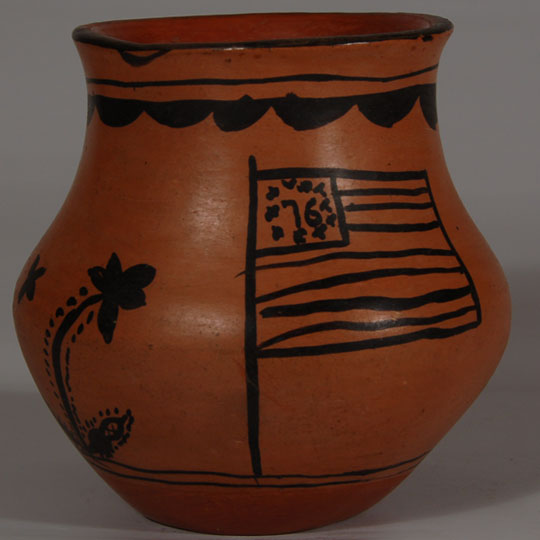 Many Native artists contributed to celebrating the 200th anniversary of the United States by producing Navajo blankets, beadwork, basketry and pottery featuring an American flag or a reference to 1776. Santana Melchor (ca.1889-1978) and her granddaughter, Darlene (ca.1950s-), produced this Black-on-red jar featuring an American flag with 76 in the stars and 76 painted on the Liberty Bell. The artists co-signed the underside of the jar.
Many Native artists contributed to celebrating the 200th anniversary of the United States by producing Navajo blankets, beadwork, basketry and pottery featuring an American flag or a reference to 1776. Santana Melchor (ca.1889-1978) and her granddaughter, Darlene (ca.1950s-), produced this Black-on-red jar featuring an American flag with 76 in the stars and 76 painted on the Liberty Bell. The artists co-signed the underside of the jar.
Original Painting of a Mudhead Katsina by Pablita Velarde - C3439E
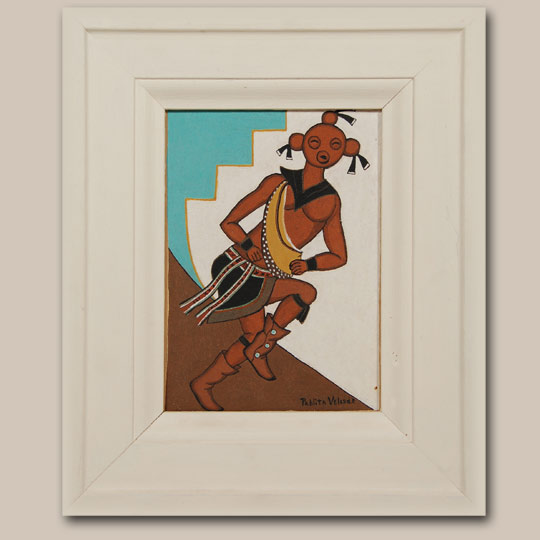 In the 1960s, when the Balcomb family operated an art gallery in Gallup, New Mexico, at 915 West Coal Avenue, Mrs. Balcomb, the family matriarch, signed a contract with Pablita Velarde (1918-2006) Tse Tsan - Golden Dawn for the Balcomb's to make silkscreen prints from four of Pablita's original mineral earth paintings. The four selected paintings were a single Koosa Clown figure, a single Mudhead Katsina figure, a pair of Koosa Clowns and a pair of Mudhead Katsinas.
In the 1960s, when the Balcomb family operated an art gallery in Gallup, New Mexico, at 915 West Coal Avenue, Mrs. Balcomb, the family matriarch, signed a contract with Pablita Velarde (1918-2006) Tse Tsan - Golden Dawn for the Balcomb's to make silkscreen prints from four of Pablita's original mineral earth paintings. The four selected paintings were a single Koosa Clown figure, a single Mudhead Katsina figure, a pair of Koosa Clowns and a pair of Mudhead Katsinas.

